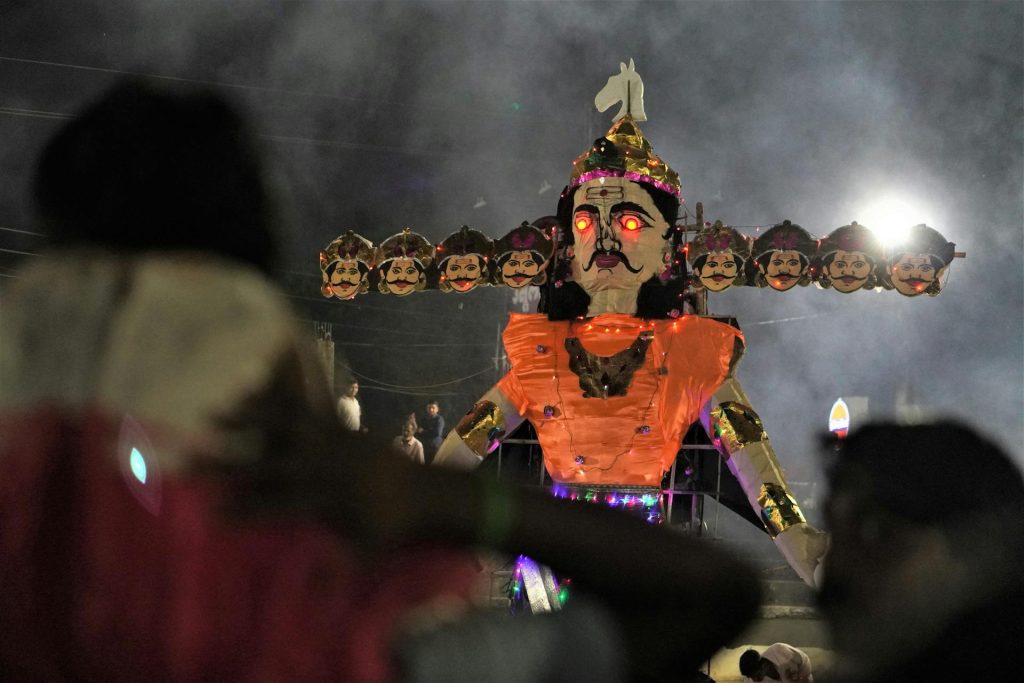Discover how is Vijayadashami celebrated across India‘s diverse regions. From vibrant Dussehra processions in North India to unique rituals in the South, explore how each region honors this auspicious festival with distinct customs and traditions.
Vijayadashami, also known as Dussehra, is one of the most significant festivals in India, symbolizing the triumph of good over evil. Celebrated on the tenth day of the Hindu lunar month of Ashwin, it marks the culmination of the nine-day festival of Navaratri. While the underlying theme of victory remains consistent, the rituals and celebrations of Vijayadashami vary remarkably across India’s diverse regions.
The Cultural Significance of Vijayadashami
Vijayadashami derives its meaning from “Vijaya” (victory) and “Dashami” (tenth day). The festival commemorates Lord Rama’s victory over the demon king Ravana and Goddess Durga’s triumph over the buffalo demon Mahishasura. Celebrated in diverse forms across India, Vijayadashami encapsulates the essence of righteousness prevailing over darkness, making it a festival that binds communities through shared values of courage, devotion, and resilience.
How is Vijayadashami celebrated in different regions in India?
Northern India: The Spectacle of Ramlila and Ravana Dahan

In Northern India, especially in states like Uttar Pradesh, Delhi, and Punjab, Vijayadashami is synonymous with the theatrical enactment of Ramlila—the dramatic retelling of Lord Rama’s life from the epic Ramayana.
- Ramlila Performances: For ten days leading up to Vijayadashami, local actors perform episodes from the Ramayana in open-air stages, culminating in the final battle between Lord Rama and the demon king Ravana.
- Ravana Dahan: On the evening of Dussehra, effigies of Ravana, his brother Kumbhakarna, and his son Meghanada are set ablaze in vast open grounds. The burning symbolizes the destruction of evil and is accompanied by fireworks and large gatherings.
Eastern India: Immersion of Goddess Durga in West Bengal
In West Bengal, Assam, and parts of Odisha, Vijayadashami marks the conclusion of Durga Puja, a festival celebrating the goddess Durga’s victory over the buffalo demon Mahishasura.
- Visarjan (Immersion): Elaborately crafted idols of Goddess Durga, along with those of her children—Lakshmi, Saraswati, Ganesha, and Kartikeya—are carried in grand processions to rivers or seas for immersion, signifying her return to the celestial abode.
- Sindoor Khela: Married women participate in the ritual of applying vermilion powder (sindoor) to the goddess and to each other, praying for marital bliss and prosperity.
Southern India: The Golu Festival and Worship of Shakti
In Tamil Nadu, Karnataka, and Andhra Pradesh, the festival is celebrated with a focus on the divine feminine energy, Shakti.
- Golu or Kolu: Families set up stepped displays of dolls and figurines, depicting gods, goddesses, and scenes from daily life. Guests are invited over the nine days to view the displays, exchange gifts, and share festive meals.
- Ayudha Puja: On the ninth day, tools, musical instruments, books, and machinery are cleaned and decorated, symbolizing gratitude and respect for the tools of one’s trade.
- Vijayadashami Initiations: The tenth day is considered auspicious for starting new ventures or learning. Children are often introduced to education, music, or dance on this day in a ceremony called Vidyarambham.
Western India: Worship of Goddess Saraswati and Shami Tree
In Maharashtra and Gujarat, Vijayadashami is a time for both celebration and introspection.
- Exchange of Apta Leaves: Known as “gold leaves,” apta leaves are exchanged among friends and family as a symbol of goodwill and prosperity.
- Worship of the Shami Tree: The Shami tree is revered, and its leaves are offered to deities. The ritual is linked to the Pandavas’ return from exile in the Mahabharata, where they hid their weapons in a Shami tree.
- Seema Avalanghan: People cross the boundaries of their villages and cities, symbolizing the conquest of new frontiers.
Central India: Traditional Dances and Fairs
In Madhya Pradesh and Chhattisgarh, the festival is marked by community gatherings and cultural performances.
- Melas (Fairs): Large fairs are organized featuring local crafts, food stalls, and entertainment rides.
- Folk Dances: Traditional dances like Matki, Phulpati, and Saila are performed, showcasing the rich cultural heritage of the region.
The Kullu Dussehra of Himachal Pradesh
One of the most unique celebrations takes place in the Kullu Valley.
- Procession of Deities: Over 200 local deities are brought in processions to the Kullu valley to pay homage to Lord Raghunathji (Lord Rama).
- Week-long Festivities: Unlike the one-day celebration elsewhere, Kullu Dussehra spans seven days, featuring cultural performances, music, and dance.
Modern Celebrations and Trends
In recent years, Vijayadashami has seen contemporary additions to traditional practices.
- Eco-friendly Effigies and Idols: With growing environmental awareness, communities are opting for biodegradable materials for effigies and idols to minimize pollution.
- Digital Ramlila: Due to technological advancements and circumstances like the COVID-19 pandemic, virtual Ramlila performances have gained popularity, allowing wider audiences to participate.
- Cultural Fusion: Urban areas witness a blend of traditions, where people from different regions celebrate together, fostering unity and cultural exchange.
FAQs:
-
How is Durga Puja connected to Vijayadashami?
Durga Puja culminates on Vijayadashami with the immersion of Goddess Durga’s idols, marking her victory over the demon Mahishasura.
-
How has Dussehra evolved in modern times?
Modern Dussehra celebrations have become eco-friendly, with biodegradable materials for idols and a reduced emphasis on fireworks. The festival is also widely shared on social media, reaching a global audience.
-
Why are effigies burned during Dussehra in Northern India?
The burning of effigies of Ravana symbolizes the destruction of evil and the victory of good, reminding people to eliminate negative traits within themselves.
Conclusion: How is Vijayadashami celebrated across India
Vijayadashami is a festival that beautifully encapsulates India’s cultural diversity and unity. Despite regional differences in rituals and celebrations, the core message remains the same—the victory of good over evil, the importance of righteousness, and the celebration of life’s blessings. As we partake in these festivities, let us embrace the rich traditions and perhaps share our own regional practices, fostering a deeper understanding and appreciation of India’s cultural mosaic.